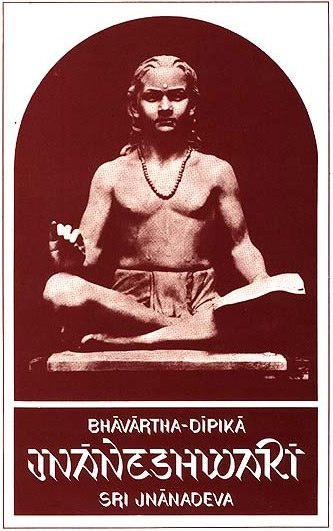Jnaneshwari (Bhavartha Dipika)
by Ramchandra Keshav Bhagwat | 1954 | 284,137 words | ISBN-10: 8185208123 | ISBN-13: 9788185208121
This is verse 13.3 of the Jnaneshwari (Bhavartha-Dipika), the English translation of 13th-century Marathi commentary on the Bhagavad-Gita.—The Dnyaneshwari (Jnaneshwari) brings to light the deeper meaning of the Gita which represents the essence of the Vedic Religion. This is verse 3 of the chapter called Kshetra and Kshetrajna Yoga.
Verse 13.3
Verse 12.3: “That Field: what it is, what-like it is, with what changing forms, and which, and from whence (originated); likewise, who that (Field-knower) is, and of what potence: that in substance hear from Me. (10)
Commentary called Jnaneshwari by Jnaneshwar:
Now I (am going to) tell you all the implications of what I said of the body being the ‘Kshetra’ (field), why is it called a Kshetra, how it originates, and what modifications tend to develop it here and by whom. It only measures three and a half cubits and whether so much (extensive) soil is barren or fertile and to whom it belongs—all these details I shall tell you and so give your attention. It is only this field that the Shruti (Vedas) is ever clamouring about, while the science of logic (tarka) carries on incessant debate to determine it. Scriptures on all the (six) subjects (darśana [darśane]) came to the end of their wits while discussing this (field), and yet there is no unanimity amongst them about it. It was on account of this that the different Scriptures got in touch with each other and discussions were held over this alone, all over the world. Yet there has neither been any agreement, nor any common feature in the (different) talks.
Only arguments and counter-arguments have increased for no (valid) reason. No one knows whom this field belongs to: yet it is coveted for so much that there are acute and violent scrambles over it in each and every house. The Vedas wield great strength to fight the unbelievers, at which these unbelievers utter nonsensical things. They say that the Vedas (i.e. the statements made therein) are without foundation and they (Vedas) only spin out cobwebs of propaganda, and if they (unbelievers) are accused of making a false statement, they lay down a betel nut (by way of a wager) and take a vow to substantiate their charge.
These unbelievers assume nudity and become bald-headed by violently uprooting their hair. How can these acts make their hollow dogma in any way sound and reasonable? Fearing that death might overtake their fields (living bodies) laying them waste for nothing, the Yogins start to protect them. They accept solitude, getting afraid of death and collect all the means necessary for observing Yama-Niyama (yamaniyama—Self-control). (Even) Lord Shan-kara abandoned his kingdom in order to annihilate passion for this very field, and accepted a stay in a funeral yard, for snapping all worldly attractions. And in order to prove true to the vow he (Lord Shankara) also assumed nudity (lit. wears ten quarters) and burnt Cupid to cinders because he tried to seduce him (Shankara). Brahmadeva (Lord of Satya-loka) was endowed with four mouths, in order to have a decisive debate on the subject, but he too was unable to know it properly.
